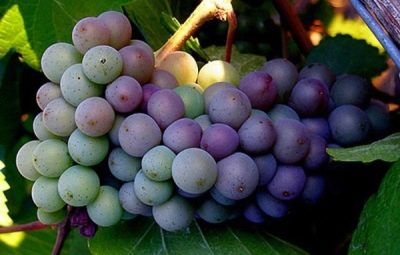
- Authors: France
- Appointment: technical
- Berry color: pinkish gray
- Taste: harmonious
- With bones: Yes
- Ripening period: mid-late
- Ripening period, days: 130-150
- Frost resistance, ° C: -20
- Name synonyms: Blauer Traminer, Burgunder Rother, Viliboner, Gres Klevner, Grauer Riesling, Grauklevner, Cordelier Gris, Malvoisie, Auverna Gris, Oxerua Gris, Pinot Boro, Pinot Grigio, Pinot gray, Frommanto Gris, Champagne
- Bunch weight, g: 87
The Pinot Gris variety is widely known for its special taste, thanks to which its fruits are used for making wine. This species is actively cultivated not only in Europe, but also within the borders of Russia.
Breeding history
The Pinot Grigio grape was originally grown only in France, and the first mentions of it appeared in the 13th century. This technical variety produced a delicious wine, which was highly appreciated by Charles IV. The Pinot Gris variety is a clone of the above variety; it is widely used in Russia.
Description
The fruit plant can be identified by its developed and powerful root system. Also, the variety has significant stature. Young shoots, which are about a year old, are colored light brown. The crown of fresh shoots is omitted. Shortened internodes are common.
Ripening period
The ripening period for fruits is from 130 to 150 days, from the moment of vegetation to harvest. This type belongs to the mid-late varieties.
Bunches
Bunches of grapes can be either cylindrical-conical or cylindrical in shape. The variety is characterized by a high density of the brush. The weight of one bunch is about 87 grams.
Berries
When ripe, the berries of the fruit crop turn pink with a noticeable gray tint. Inside you can find 2 to 4 bones. The pulp is dense and juicy, covered with a thin skin, which is almost invisible when eating the fruit. The acidity index is from 4.5 to 7 g / dm³. The sugar content is 250 g / dm³.
The size of the berries is considered to be medium and ranges from 7 to 15 millimeters in diameter. The standard shape is round, but the fruit is often deformed.
Taste
The taste of the fruit is described as harmonious and pleasant, with a delicate fruity aftertaste. The gastronomic quality of the harvest allows the use of grapes for making wine.
Yield
The Pinot Gris variety belongs to the medium-yielding varieties. One bush contains more than 50% of fruitful shoots. About 9 tons of fruits are harvested from a hectare of plantations (in industrial growing conditions). Experts note that the small amount of the harvest is fully compensated by the taste of the resulting wine.


Growing features
To get a stable harvest, it is necessary to adhere to agricultural techniques, especially in the first 3 years of the plant's life. Despite the medium vigor, the grapes need regular pruning. Also, the variety can withstand frost.
Landing
When planting seedlings, fertile soil is chosen, it will be possible to grow the richest harvest on it. The variety does not develop well on saline and acidic soils.A well-lit area located on a hill or slope is great. Also grapes thrive on alkaline or neutral soil.
The optimal distance between rows of bushes is about a meter. The dimensions of the pit for planting are 80x80 centimeters. Before you start planting the plant, the roots must be soaked in water and left for 24 hours. The root system can be pruned slightly if necessary. Humus is often added to the holes to make the soil more fertile.

Pollination
During flowering, the grapes are covered with flowers of both sexes, due to which they pollinate on their own.
Pruning
An important condition for the full development of a plant is periodic pruning. The work is carried out in the spring, after removing the covering material. Extra shoots are also removed: dry, broken, weakened. It is tedious to tie the renewed vine to the pegs prepared in advance.

Watering
In the process of active development, the bushes are watered about once a month, depending on weather conditions. 10 liters of water are consumed per plant. In late summer and early autumn, irrigation is temporarily stopped. For grapes, you can use drip irrigation. The last time the bushes are watered after harvesting the fruits, in October.


Top dressing
Fertilizers are administered 3 times per season. Nitrogen fertilizing is used in the spring, during the swelling of the buds. For the second time, use complex formulations or ready-made preparations ("Plantafol", "Kemira"). The last time fertilizer is applied after picking berries, in the fall. Organics are preferred.
Frost resistance and the need for shelter
The plant can withstand frosts up to 20 degrees Celsius, while it needs to be covered for the winter. Trenches are made between the rows, where the vine is laid. After it is covered with a film, earth or other material. Sluggish leaves and dry shoots must be removed before shelter. It is recommended to additionally treat the plant for diseases.

Diseases and pests
To prevent grapes from getting sick with mildew or oidium, the vine must be regularly sprayed with special protective compounds. Bordeaux mixture and preparations "Topaz", "Horus", "Strobi" have become widespread. The processing is stopped when the fruit is poured.

If a grape is exposed to any disease or insect, this always affects its appearance.
Storage
The fruits are stored in a cool and dark place. Before making wine, they are left to lie down for about a month so that the berries are fermented.











































































